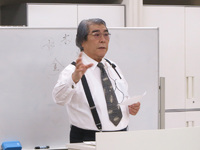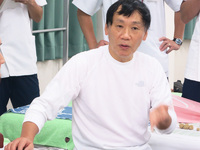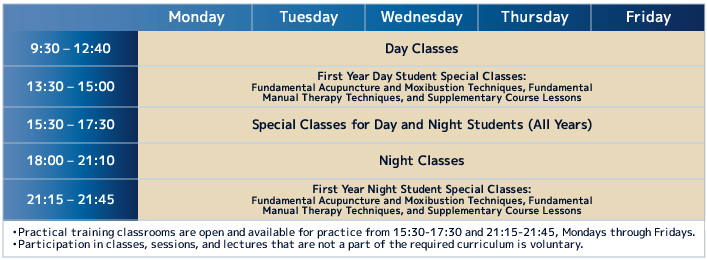Improve Your Skills by Choosing to Participate
Special Lectures (Participation Voluntary)
Toyoshinkyu alumni active on the front lines of clinical practice present practical and warm-hearted messages to current students during special lectures. The exquisite skill and conversational prowess that are the mark of clinical practitioners with a wealth of clinical experience are a must-see.
Previous Special Lectures
| * Information on concluded Special Lectures is posted on the Ibuki Blog (Japanese) | |
|---|---|
| Fumichika Takemura (1) | The First Step in Acupuncture and Moxibustion: What it Means to Truly Learn |
| Katsuo Miura (1) | Yanagiya Style’s Secret Single Needle Technique |
| Hirotoshi Amano | (For the public and practitioners of acupuncture and moxibustion) An Introduction to Dementia |
| Tsutomu Shinohara | The Effects of Single Needle Acupuncture |
| Fumichika Takemura (2) | Now is the Time for Change, Practitioners of Acupuncture and Moxibustion |
| Katsuo Miura (2) | The Flow of Meridians: Yanagiya Style Single Acupuncture Needle |
| Fumichika Takemura (3) | Let’s Become Able to Insert Needles! |
| Fumichika Takemura (4) | Toyoshinkyu’s “Good Old Days”: A Master and Pupil Interview with 3000 Keisatsu (light strokes) Practitioner Ryota Inoue |
| Katsuo Miura (3) | The Flow of Meridians: Yanagiya Style Single Acupuncture Needle |
| Fumichika Takemura (5) | More Keisatsu (light strokes)! More Needle Insertion! |
| Fumichika Takemura (6) | How to Develop Your Hands so You Can See with Your Hands |
| Katsuo Miura (4) | Yanagiya Style Single Needle Acupuncture |
| Fumichika Takemura (7) | The Fundamentals of Body Contact (Kyutoshin: Needle Moxibustion) |
| Sachiyo Ako | Therapy to Adjust Meridian Balance |
| Fumichika Takemura (8) | Pediatric Acupuncture |
| Katsuo Miura | Yanagiya Style Single Needle Acupuncture |
| Fumichika Takemura (9) | Continuation of Previous Lecture (Pediatric Acupuncture) |

Katsuo Miura: Yanagiya Style Single Needle Acupuncture

Fumichika Takemura: Acupuncture and Moxibustion: What it Means to Truly Learn
Special Classes (Participation Voluntary)
Special classes are where interested students from different courses and school years gather together to seek instruction in a terakoya style class from instructors well versed in the world of oriental medicine. All of the special class instructors are renowned individuals that even practitioners already working in a clinical setting would beg for instruction. These special classes provide an environment where the only limit on learning is class time.
Participating in special classes such as “Fundamental Acupuncture and Moxibustion Techniques, Fundamental Manual Therapy Techniques, and Supplementary Course Lessons” held after the respective end of regular classes for the day and night programs makes it possible to increase one’s understanding of medicine and to improve one’s level of skill.
These sessions are not a part of the required curriculum and participation is voluntary (optional).
Session Content (tentative)
Shakuju Treatment Acquisition, Renseikai, Applications of the Nine Classical Acupuncture Needles, Traditional Japanese Acupuncture and Moxibustion Techniques, Classical Literature Study Group, Akabane Style Treatments Utilizing Heat Sensitivity and Daikoku Treatments, “The Acupuncture Training Group” – Improving with Friends, Keiraku (Meridian) Anma, and Contact Needling

Toyoshinkyu provides special classes, supplemental course lessons, and fundamental manual therapy technique practice at times outside class hours for the day and night programs (9:30-12:40 and 18:00-21:10, respectively). This curriculum is open to any students who want to attend.
Open Hours for Practical Training Classrooms (Participation Voluntary)
Open hours for practical training classrooms are from 15:30-17:30 and 21:15-21:45, Mondays through Fridays. This time is for individual technique and skills practice. During open hours, a faculty member is present to supervise and is available to answer questions or perform technique checks.
For more information on the participatory clinical practicum, see “Substantial Instruction in Practical Technique, Including Participatory Clinical Practicums.”
For more information on practical training classes, see “About Practical Training Classes.”
Post-Graduation Support for Skill Development
Support Program for the Opening of Private Practices
Toyoshinkyu allows alumni to use the treatment space inside the clinic owned by our educational foundation. This space is available to graduates who want to open their own private practice in the future, as well as to practitioners who currently do not have their own practices. Toyoshinkyu will continue to do whatever it can to contribute to the development of acupuncture, moxibustion, and anma/massage/shiatsu.
For more information see the Sorei Yanagiya Memorial Acupuncture and Moxibustion Clinic homepage (Japanese)
Post-Graduation Training Program
< Details of Post-Graduation Education >
1. The objective of post-graduation training is for a trainee to become able to appropriately assess a patient and provide proper treatment, once the trainee has excluded those cases where acupuncture, moxibustion, and/or anma/massage/shiatsu are contraindicated or inappropriate.
2. Once training reaches its final stages, the objective is for a trainee to be the sole person who provides treatment for an incoming patient on a regular basis. At this stage, the trainee is able to apply the knowledge and skills they have acquired to that point.
3. Post-graduation education proceeds in stages in order to achieve these objectives. Each stage contains multiple training categories, which trainees complete in order.
4. A class where student numbers are kept low is taught three or four times a month by an instructor with a wealth of clinical experience. These classes focus on practical technique.
5. Trainees can participate (voluntarily) in the special lectures and special classes (extracurricular classes) offered to currently enrolled Toyoshinkyu students.


